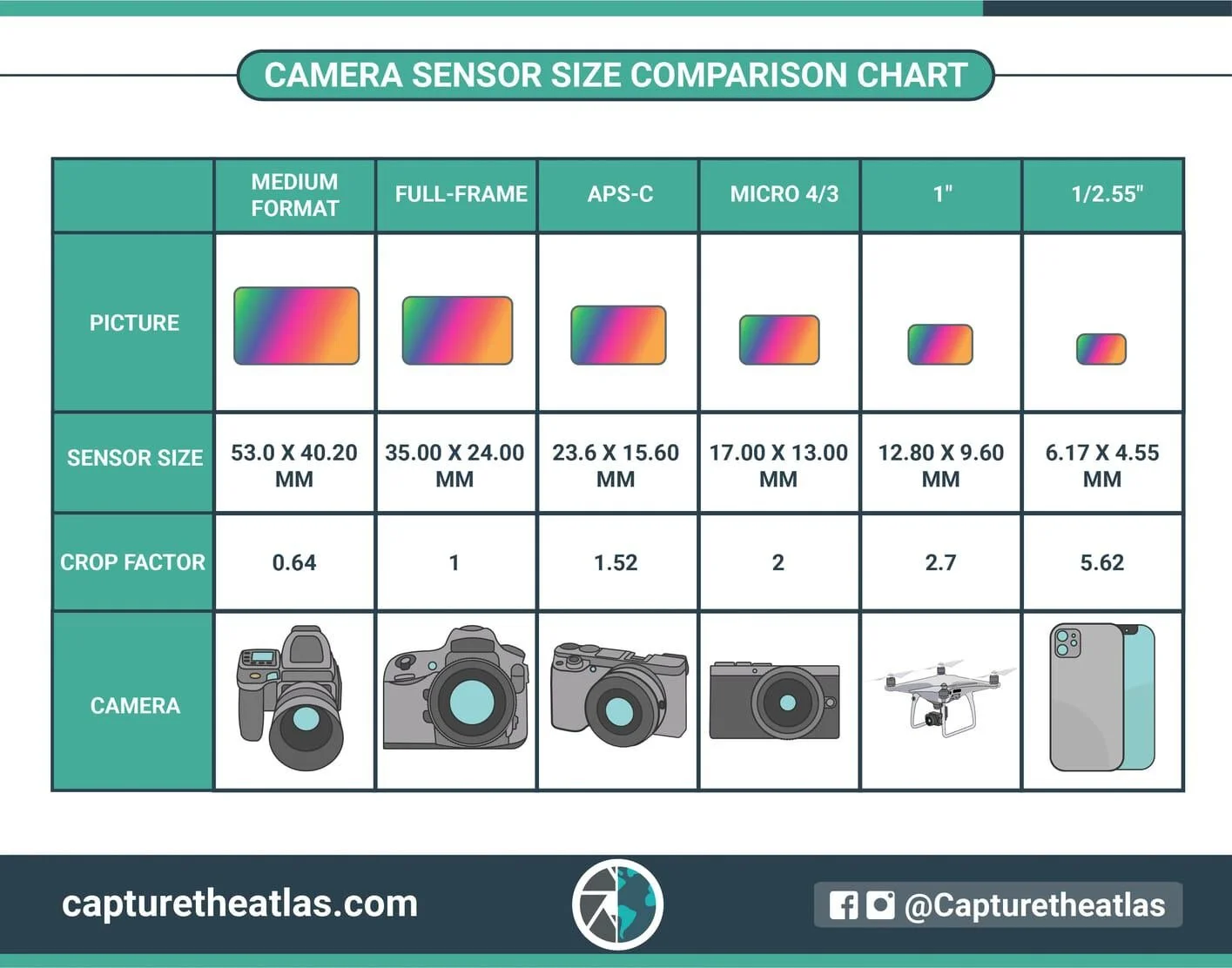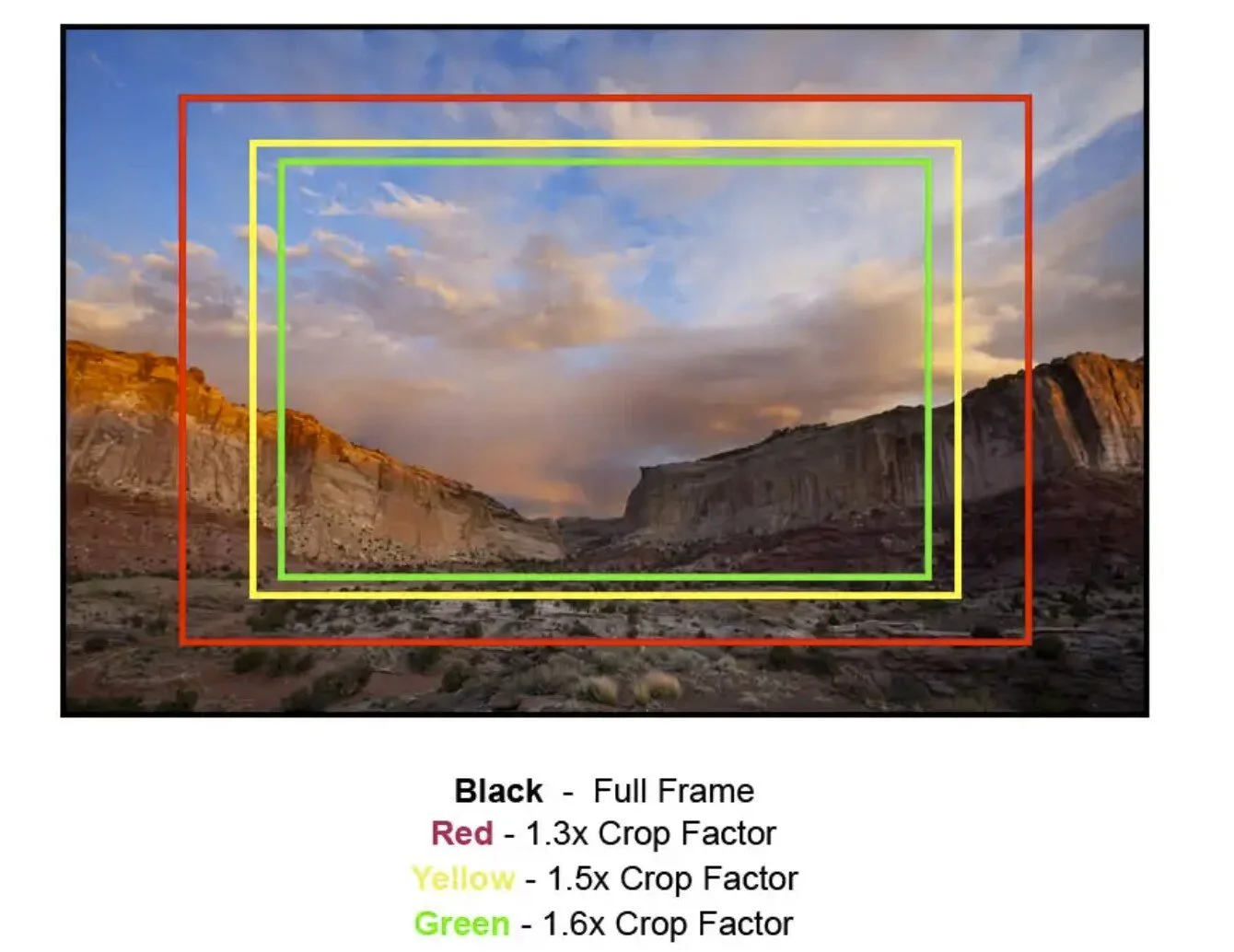14 FULL FRAME VS CROPPED SENSOR: Which One reigns Supreme?
Table of Contents Show
Introduction
Understanding camera sensors: Full frame vs cropped sensor
In the ever-evolving world of digital photography, the debate between full frame vs crop sensor cameras has been a topic of intense discussion. As an experienced photographer, I have had the privilege of working with both types of sensors, and it's time to shed light on this captivating crop sensor vs full frame dilemma.
Summary of the different sensor Sizes
A full-frame camera has a sensor that is the same size as a 35mm film frame, measuring approximately 36mm x 24mm. On the other hand, a crop sensor camera, also known as an APS-C sensor, is smaller, typically around 22mm x 15mm. This size difference has significant implications for image quality, depth of field, and focal length equivalence, among other factors
Advantages of full frame cameras
Superior Image Quality: Full frame sensor cameras have larger individual photosites, which translates to better light-gathering capabilities and lower noise levels, especially in low-light situations. This results in images with greater dynamic range, richer colours, finer details, and higher image resolution.
Shallow Depth of Field: Due to the larger sensor size, full frame photography allows you to achieve a shallower depth of field at the same aperture and focal length settings compared to crop sensor cameras. This characteristic is highly desirable for portrait photography, where a beautifully blurred background (bokeh effect) can isolate the subject and create a visually stunning effect.
Wide Angle Versatility: Full frame cameras can take full advantage of wide-angle lenses, capturing expansive scenes without the need for specialized ultra-wide lenses. This flexibility is invaluable for landscape photography, architectural, and interior photography.
Advantages of cropped sensor cameras
Effective Focal Length Magnification: The smaller sensor size of crop sensor cameras results in a crop factor, which effectively multiplies the focal length of a lens. For example, a 50mm lens on an APS-C crop factor camera with a 1.6x crop factor behaves like an 80mm lens on a full frame camera. This characteristic can be advantageous for sports photography, wildlife photography, and action photography, where longer focal lengths are often desired.
Compact and Lightweight Design: Crop sensor cameras tend to be smaller and lighter than their full frame counterparts, making them more portable and easier to carry around for extended periods. This reduced camera body size and camera weight can be a significant advantage for travel, street, and outdoor photography.
Cost-Effective: Crop sensor cameras and their associated lenses are generally more affordable than their full frame equivalents, making them an attractive option for those on a tighter budget or just starting their photography journey. The smaller lens size also contributes to the overall cost savings.
Image quality comparison: Full frame vs cropped sensor
When it comes to image quality, full frame cameras undoubtedly have an edge over their cropped sensor counterparts. The larger full frame sensor allows for better light-gathering capabilities, resulting in superior dynamic range, colour depth, light sensitivity, and low-light performance. However, advancements in sensor technology have narrowed the gap, and modern crop sensor cameras can produce exceptional image quality, especially in well-lit conditions. The difference in megapixels between the two sensor types has also become less significant in recent years.
Depth of field and low light performance: Full frame vs cropped sensor
One of the most notable advantages of full frame cameras is their ability to achieve a shallower depth of field at the same aperture and focal length settings compared to crop sensor cameras. This characteristic is highly prized in portrait and product photography, where a beautifully blurred background can isolate the subject and create a visually stunning effect.
Additionally, full frame sensors excel in low-light situations due to their larger photosites and superior light-gathering capabilities. This allows for cleaner images with less noise (noise reduction), even at higher ISO settings (high ISO sensitivity and ISO performance), making full frame cameras a preferred choice for event, wedding, and astrophotography.
Crop factor and focal length equivalence
The crop factor is a term used to describe the difference between full frame and crop sensor cameras in terms of effective focal length. For example, an APS-C sensor with a crop factor of 1.6x means that a 50mm lens on that camera will have an effective focal length of 80mm (50mm x 1.6) when compared to a full frame sensor.
This crop factor can be advantageous for photographers who require longer focal lengths, such as those shooting sports photography, wildlife photography, or action. The increased telephoto reach can be achieved without the need for expensive long lenses. However, it can also be a limitation for those who prefer wider angles (wide-angle photography), as they may need to invest in specialized ultra-wide lenses to achieve the desired field of view.
Price considerations: Full frame vs cropped sensor
One of the most significant factors influencing the choice between full frame and crop sensor cameras is the cost. Full frame cameras and their associated lenses tend to be more expensive than their cropped sensor counterparts. This price difference can be substantial, especially for professional-grade equipment.
However, it's important to consider the long-term investment and potential return on investment. While crop sensor cameras may be more affordable initially, the need to upgrade to specialised lenses or invest in a full frame camera system later on could offset the initial cost savings.
Lens compatibility and availability: Full frame vs cropped sensor
When it comes to lens selection and availability, full frame cameras have a distinct advantage. Most camera manufacturers offer a wider range of lenses designed specifically for full frame sensors, providing greater versatility and creative options.
On the other hand, crop sensor cameras are often limited to lenses designed for their specific sensor size or compatible with full frame lenses with potential vignetting or cropping issues. This can be a significant consideration for photographers who require specialized lenses or plan to expand their lens collection in the future. The lens size comparison between full frame and crop sensor systems is also worth noting, as full frame lenses tend to be larger and heavier.
Choosing the right camera for your needs
Ultimately, the choice between a full frame camera or crop sensor camera boils down to your specific needs, shooting style, and budget. If you prioritize exceptional image quality, low-light performance, and shallow depth of field, a full frame camera may be the way to go. However, if portability, affordability, and the ability to capture distant subjects with effective focal length magnification are more important, a crop sensor camera could be the better option.
It's also worth considering the type of photography you primarily engage in. For instance, a full frame camera may be the preferred choice for professional portrait, landscape photography, or commercial photographers, while a crop sensor camera could be more suitable for sports photography, wildlife photography, or travel photographers.
Conclusion
In the realm of digital photography, the debate between full frame and crop sensor cameras is a complex one, with each option offering its unique advantages and trade-offs. While full frame cameras undoubtedly excel in areas such as image quality, low-light performance, and depth of field control, crop sensor cameras provide a more affordable and portable solution, coupled with the benefits of effective focal length magnification.
As photographers, it's crucial to understand our individual needs, shooting styles, and budgets before making an informed decision. Factors such as megapixels, field of view, autofocus performance, and lens size should all be taken into consideration. Ultimately, the true magic lies not in the camera itself but in the creativity, passion, and vision of the photographer behind the lens.
If you're still unsure about which camera system is right for you, consider reaching out to me for personalized guidance. With my extensive experience in both full frame photography and cropped sensor photography, I can help you navigate this full frame vs crop sensor dilemma and make an informed decision that aligns with your specific needs and goals. Don't hesitate to contact me for a consultation, and let's embark on a journey to unlock your full creative potential.
FAQs Full Frame Vs Cropped Sensor
Q1: What is the difference between a full-frame sensor and a cropped sensor?
A1: A full-frame sensor has dimensions equivalent to a 35mm film frame, measuring approximately 36 x 24 mm. A cropped sensor, often referred to as an APS-C sensor, is smaller, measuring around 22 x 15 mm. This size difference affects the field of view and depth of field of the lenses used on these cameras.
Q2: How does the sensor size affect the field of view?
A2: The field of view (FOV) is narrower on a cropped sensor due to its smaller size. This results in a crop factor typically around 1.5x or 1.6x, depending on the brand. For example, a 50mm lens on a full-frame camera will provide a field of view equivalent to a 75mm lens on an APS-C camera, making the cropped sensor ideal for long-range shots.
Q3: Which sensor type is better for low-light photography?
A3: Full-frame sensors generally perform better in low-light conditions because they have larger individual pixels that can gather more light. They typically exhibit less noise at higher ISO settings, making them preferable for low-light scenarios such as indoor events or nighttime photography.
Q4: Are full-frame cameras more expensive than cropped sensor cameras?
A4: Yes, full-frame cameras tend to be more expensive than cropped sensor cameras. This higher price is due to the advanced technology, larger sensor, and typically superior image quality and performance. However, there are budget-friendly options available in both categories.
Q5: What are the advantages of using a cropped sensor camera?
A5: Cropped sensor cameras have several advantages, including:
Cost-Effectiveness: Generally lower-priced than full-frame options.
Portability: Often lighter and more compact, making them easier to carry for travel.
Extended Reach: The crop factor effectively extends the focal length of lenses, which is beneficial for wildlife or sports photography.
Q6: What type of photography is best suited for full-frame sensors?
A6: Full-frame sensors excel in various photography styles, particularly:
Landscape Photography: The wider field of view and better dynamic range contribute to detailed, expansive shots.
Portrait Photography: The shallower depth of field allows for beautiful background bokeh.
Low-Light Photography: Better performance at high ISOs makes them ideal for evening portraits or events.
Q7: Can I use full-frame lenses on a cropped sensor camera?
A7: Yes, you can use full-frame lenses on cropped sensor cameras, but the effective focal length will be multiplied by the crop factor. For example, a 24-70mm full-frame lens will have an equivalent field of view of about 36-105mm on an APS-C camera.
Q8: Is it possible to print large photos from a cropped sensor camera?
A8: Yes, you can print large photos from a cropped sensor camera, but the resolution and detail may not match that of a full-frame camera, especially when enlarging significantly. The print quality will depend on the megapixels of the cropped sensor, lens quality, and how the image is processed.
Q9: Should a beginner start with a full-frame or cropped sensor camera?
A9: Beginners generally benefit from starting with a cropped sensor camera due to its lower cost, user-friendly options, and lighter weight. As they gain experience and develop specific photography interests, they may consider upgrading to a full-frame camera later.




